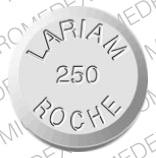Lariam and Alcohol/Food Interactions
There is 1 alcohol/food/lifestyle interaction with Lariam (mefloquine).
Mefloquine Food/Lifestyle
Moderate Food Interaction
ADJUST DOSING INTERVAL: Food enhances the oral absorption and bioavailability of mefloquine. The proposed mechanism is increased drug solubility in the presence of food. In 20 healthy volunteers, administration of a single 750 mg oral dose of mefloquine 30 minutes following a high-fat meal increased the mean peak plasma concentration (Cmax) and area under the concentration-time curve (AUC) of mefloquine by 73% and 40%, respectively, compared to administration in the fasting state. The Cmax and AUC of the carboxylic acid metabolite were also increased by 35% and 33%, respectively, compared to fasting. In addition, the time to reach peak plasma concentration (Tmax) of mefloquine was significantly shorter after food intake (17 hours) than in the fasting state (36 hours). There was no difference in the elimination half-life of mefloquine and metabolite, or the Tmax for the metabolite.
MANAGEMENT: To ensure maximal oral absorption, mefloquine should be administered immediately after a meal with at least 8 ounces of water.
References (2)
- (2021) "Product Information. Mefloquine Hydrochloride (mefloquine)." Hikma USA (formerly West-Ward Pharmaceutical Corporation)
- Schmidt LE, Dalhoff K (2002) "Food-drug interactions." Drugs, 62, p. 1481-502
Switch to consumer interaction data
Lariam drug interactions
There are 428 drug interactions with Lariam (mefloquine).
Lariam disease interactions
There are 4 disease interactions with Lariam (mefloquine) which include:
More about Lariam (mefloquine)
- Lariam consumer information
- Check interactions
- Compare alternatives
- Reviews (15)
- Drug images
- Side effects
- Dosage information
- During pregnancy
- Drug class: antimalarial quinolines
- Breastfeeding
Related treatment guides
Drug Interaction Classification
| Highly clinically significant. Avoid combinations; the risk of the interaction outweighs the benefit. | |
| Moderately clinically significant. Usually avoid combinations; use it only under special circumstances. | |
| Minimally clinically significant. Minimize risk; assess risk and consider an alternative drug, take steps to circumvent the interaction risk and/or institute a monitoring plan. | |
| No interaction information available. |
See also:
Further information
Always consult your healthcare provider to ensure the information displayed on this page applies to your personal circumstances.


